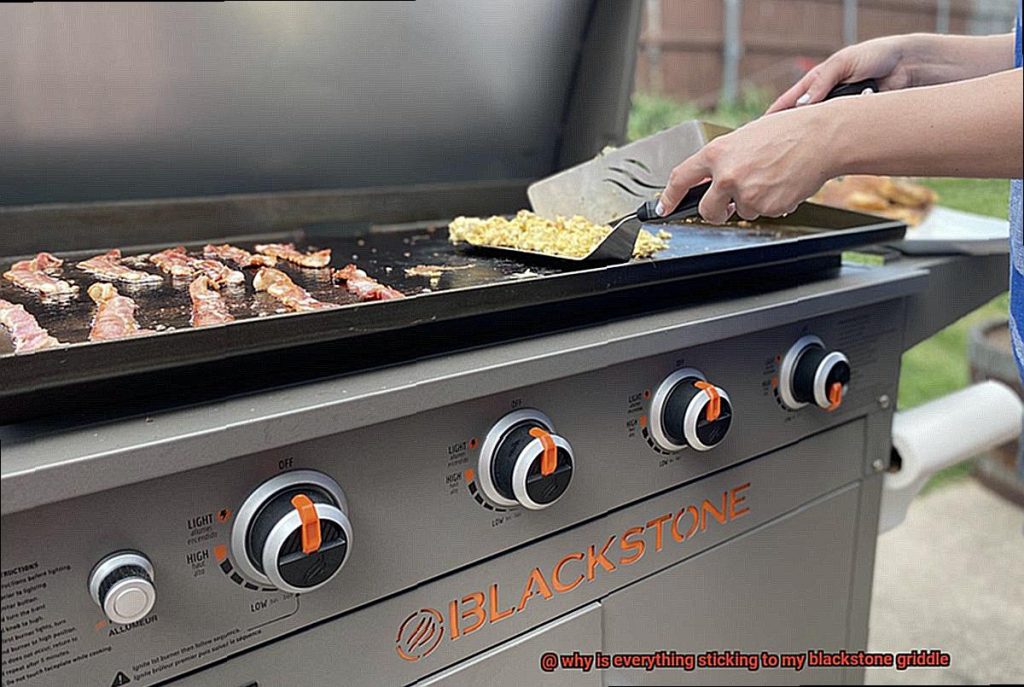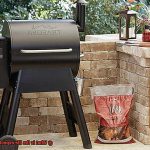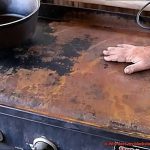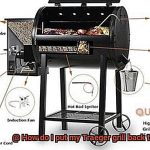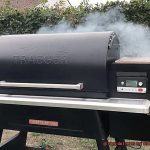Are you tired of the endless struggle to remove stubborn food particles from your Blackstone griddle? Do you find yourself constantly scraping and scrubbing, only to have everything stick again on your next cooking session? Well, let’s put an end to that frustration.
In this blog post, we’ll delve into the reasons why your food is sticking and provide practical solutions to help you overcome this issue. From the type of oil you use to the temperature of the griddle, there are several factors that can contribute to this problem. We’ll explore each one in detail and offer tips on how to avoid them altogether.
But it’s not just about preventing sticking – it’s also about achieving that perfect sizzle and sear every time. That’s why we’ll discuss the importance of seasoning your griddle and how to properly clean it for optimal performance.
Whether you’re a seasoned pro or a newbie in the world of griddling, our tips and tricks will help you cook like a boss without any obstacles. So sit back, relax, and read on to discover why everything is sticking to your Blackstone griddle – and more importantly – how to fix it.
Contents
What is a Blackstone Griddle?
The Blackstone Griddle provides consistent and even heat distribution, making it perfect for a wide range of foods.
One of the standout benefits of the Blackstone Griddle is its versatility. Whether you’re cooking for one or a crowd, this appliance can handle it all. Its large cooking surface is perfect for preparing meals in advance or cooking for large groups of people. And with adjustable heat controls, you can easily adjust the temperature to suit your cooking needs.
But what about food sticking to the surface? It’s a common issue, but fear not. Proper seasoning is crucial to creating a non-stick surface that prevents food from sticking and makes clean-up a breeze. And if your griddle is already seasoned, make sure to preheat it properly and use the right type of oil or cooking spray to prevent sticking.
Why Does Everything Stick to a Blackstone Griddle?
You’ve got your ingredients all set and ready to cook up a storm on your Blackstone griddle, but as soon as you start cooking, everything starts sticking. It’s frustrating and discouraging when food sticks to your griddle, but don’t worry – we’re here to help you understand why this happens and how to prevent it.
Temperature is the first factor to consider. A Blackstone griddle needs to be at the right temperature for your food to cook evenly and without sticking. If the griddle is not hot enough, your food will stick, but if it’s too hot, your food will burn and stick. So make sure you preheat your griddle to the right temperature before adding any food.
Next up is seasoning. A well-seasoned griddle creates a non-stick surface that prevents food from sticking. If you haven’t seasoned your griddle yet, don’t worry – it’s easy to do. Simply apply a thin layer of oil all over the surface of the griddle and heat it up until it smokes. Repeat this process a few times until the surface is well coated.
The type of oil you use can also have an impact on whether or not your food will stick. Vegetable oil has a higher smoke point than olive oil, which means it’s less likely to stick. Be mindful of how much oil you’re using too – too much can cause your food to stick.
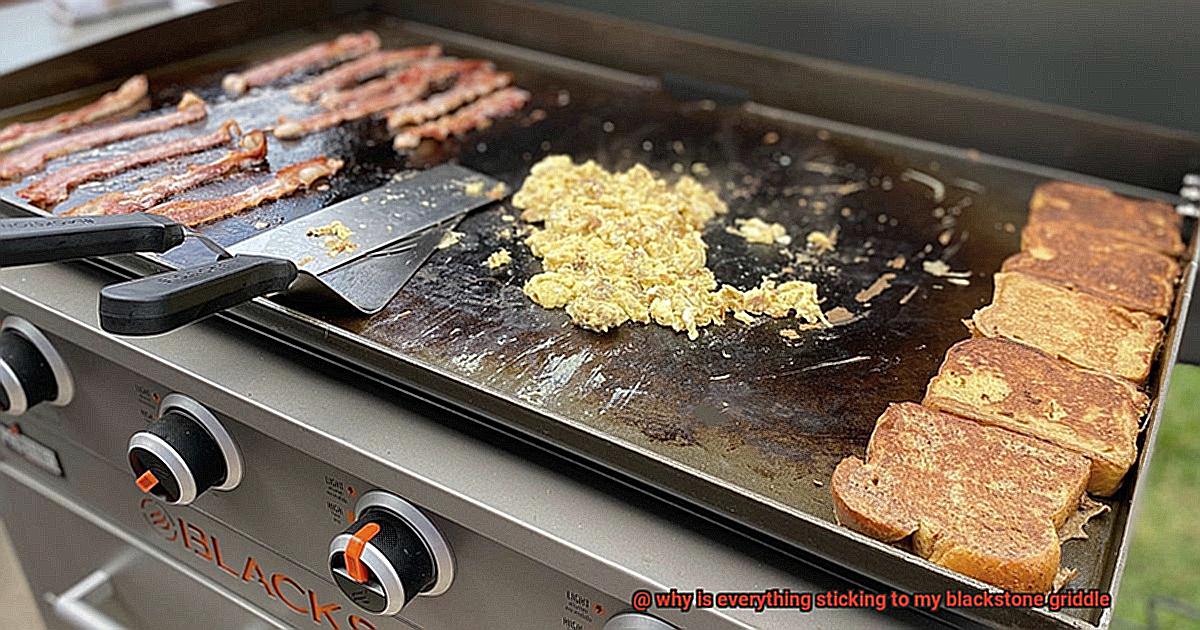
Lastly, consider the type of food you’re cooking. Foods with high sugar content, such as pancakes and French toast, are more likely to stick. Adjust your heat and oil accordingly to prevent sticking.
In summary, here are some tips to prevent food from sticking to your Blackstone griddle:
- Preheat your griddle to the right temperature before adding any food.
- Season your griddle properly with a thin layer of oil.
- Use an oil with a high smoke point like vegetable oil.
- Adjust heat and oil based on the type of food you’re cooking.
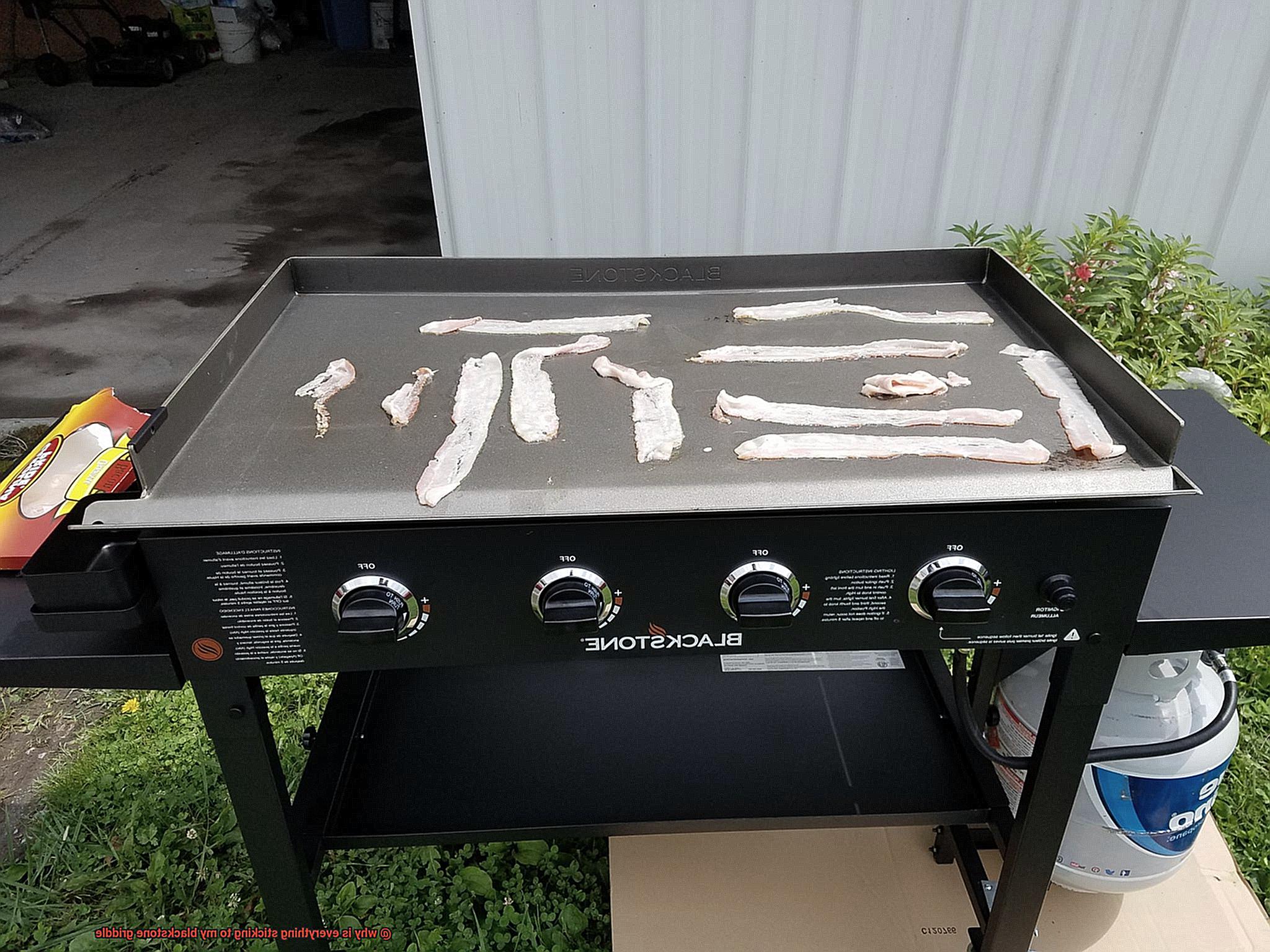
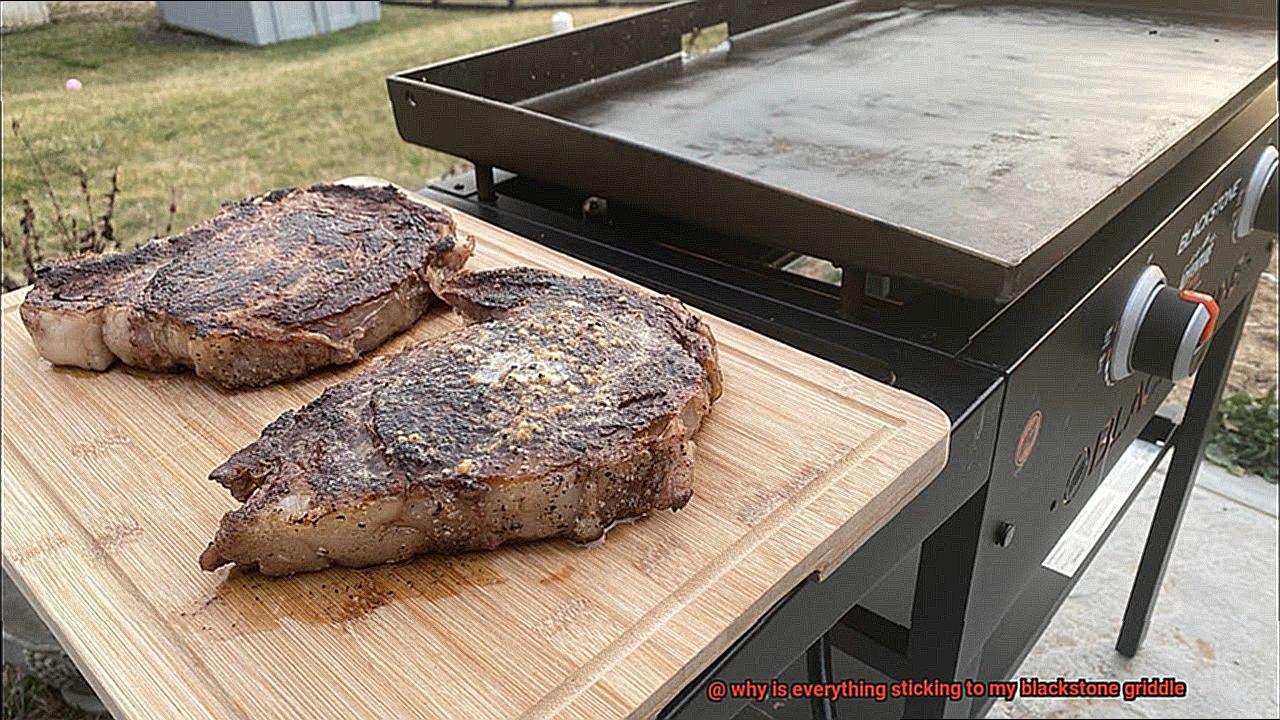
The Importance of Seasoning Your Griddle
The solution is simple: season your griddle. Seasoning your blackstone griddle is a crucial step in ensuring that your meals are cooked to perfection every time.
Not only does seasoning create a non-stick surface, but it also creates a protective layer on the griddle’s surface to prevent rust and corrosion caused by exposure to moisture or acidic foods. This protective layer prolongs the lifespan of your griddle and reduces maintenance needs.
In addition to even cooking and protection against rust, seasoning also adds a burst of flavor to your meals. The oil used during the seasoning process builds up on the surface over time, becoming infused with the flavors of the foods you cook. This unique flavor profile elevates your dishes to a whole new level.
But remember, seasoning is not a one-time process. Regular cleaning and re-seasoning of your griddle is necessary to maintain its non-stick properties and prevent rust and corrosion. Luckily, it’s easy. Simply scrape off any food debris with a scraper or spatula, wipe clean with a damp cloth, apply a thin layer of oil, and heat for several minutes.
Preheating and Maintaining the Right Cooking Temperature
To ensure that your dishes come out perfectly cooked without any sticking issues, preheating and maintaining the right cooking temperature are paramount.
Preheating your griddle is essential before you start cooking. It allows for even distribution of heat and prevents hot spots, which can cause food to stick. Give it at least 10-15 minutes on high heat to heat up before adding any ingredients. Trust us, this step is worth the wait.
But preheating is only half of the story. Maintaining the right cooking temperature throughout the cooking process is equally important. The ideal temperature range for a Blackstone griddle is between 350-400°F. If it’s too low, your food will stick, and if it’s too high, it can burn and stick as well.
Not sure how to tell if your griddle is at the right temperature? No worries. You can use a thermometer or simply pay attention to the color of the griddle. When it’s at the proper temperature, it should have a light gray or tan color. If it’s too dark, it’s too hot, and if it’s too light, it’s too cold.
Another pro-tip for preventing sticking is to use a high smoke point oil, such as vegetable oil or canola oil, before adding your ingredients. Spread a thin layer of oil on the cooking surface using a paper towel or brush. This will help create a non-stick surface and prevent food from sticking.
To sum up, here are some key tips:
- Preheat your Blackstone griddle for at least 10-15 minutes on high heat
- Maintain the right cooking temperature range between 350-400°F
- Use a thermometer or pay attention to the color of the griddle to determine if it’s at the right temperature
- Use a high smoke point oil like vegetable or canola oil to create a non-stick surface
Using the Right Type of Oil or Cooking Spray
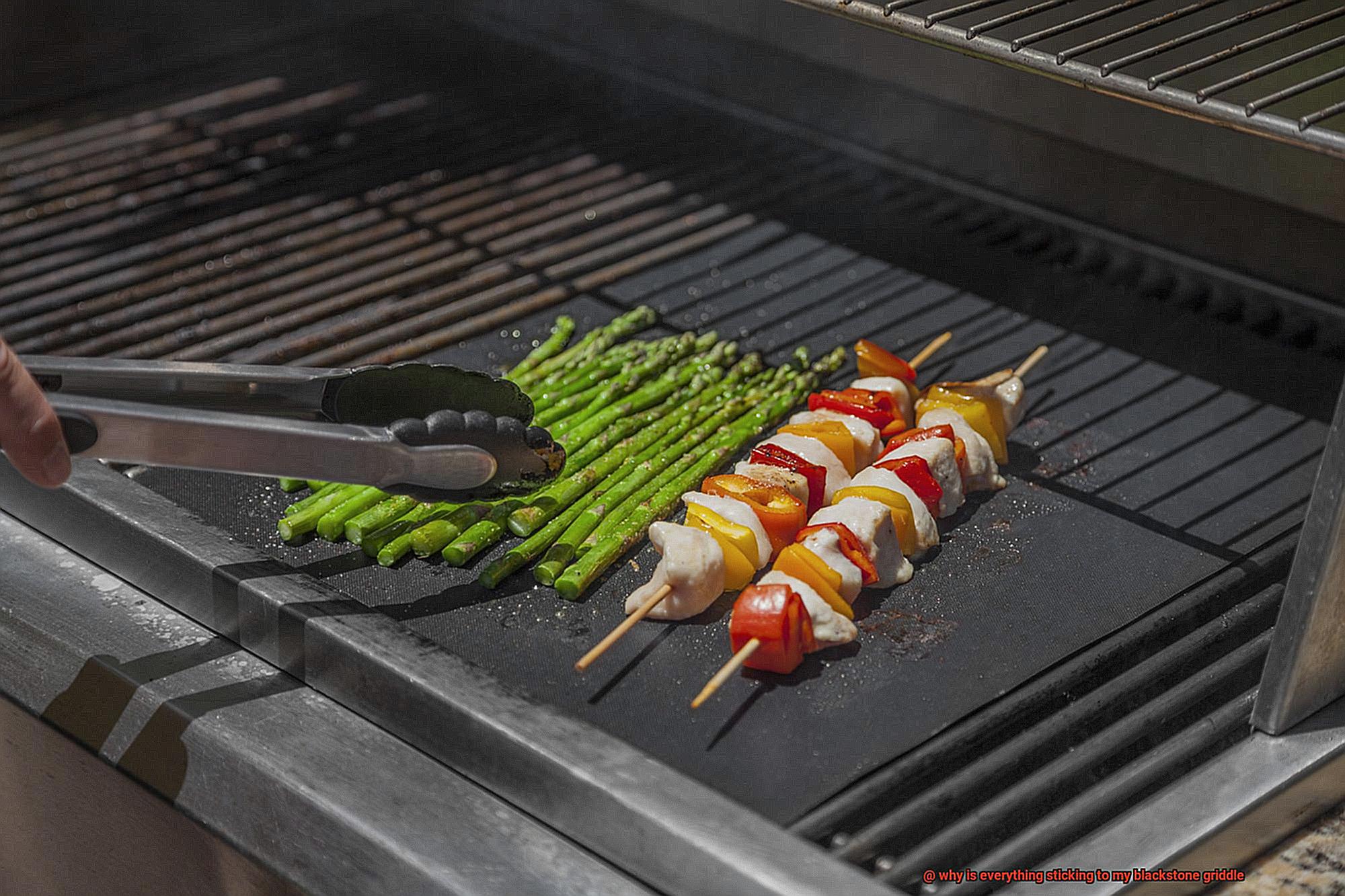
Nothing ruins a perfectly cooked meal like burnt-on food that’s difficult to scrape off.
To avoid this, the first step is to choose an oil with a high smoke point, such as canola, vegetable, or grapeseed oil. These oils can withstand high temperatures without burning or smoking, making them perfect for griddle cooking.
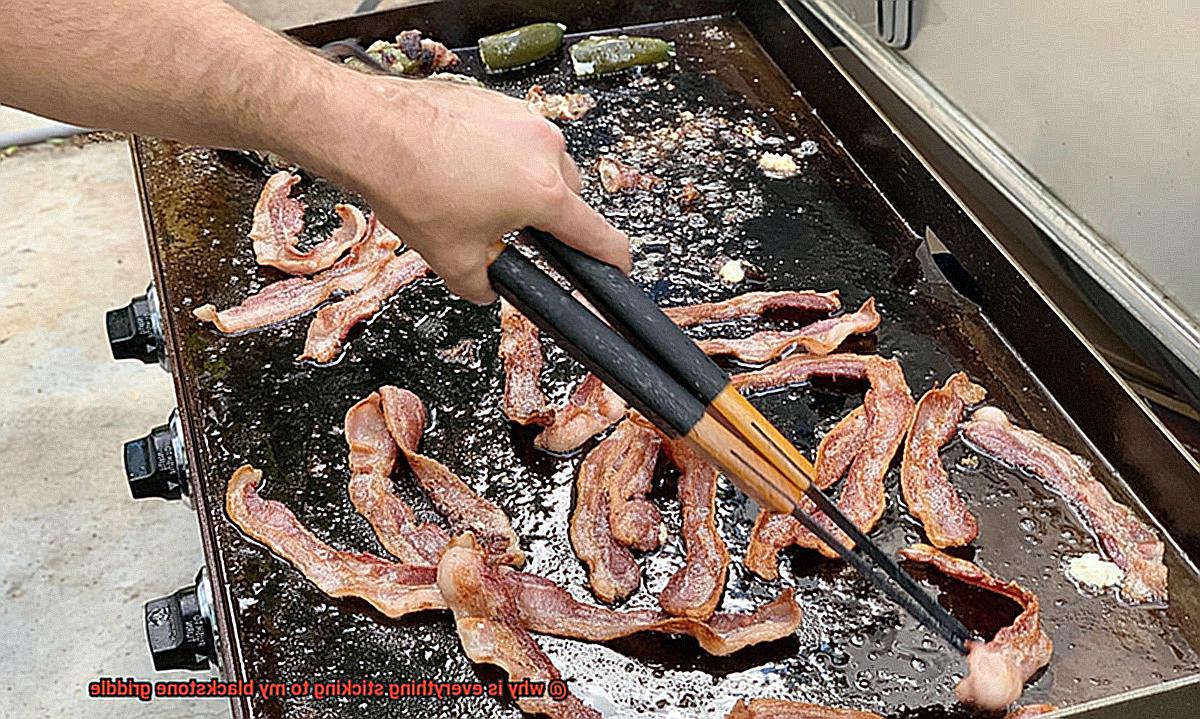
Once you’ve selected your oil, it’s important to apply it correctly to ensure that the entire surface of the griddle is coated. You can use a silicone brush or a paper towel to spread the oil evenly across the surface. This small but crucial step creates a non-stick barrier that makes all the difference when it comes to preventing food from sticking.
If you prefer using a cooking spray, hold the can about 6-8 inches away from the griddle and spray in a sweeping motion. Be careful not to overspray, as this can lead to an excess buildup on the surface of your griddle.
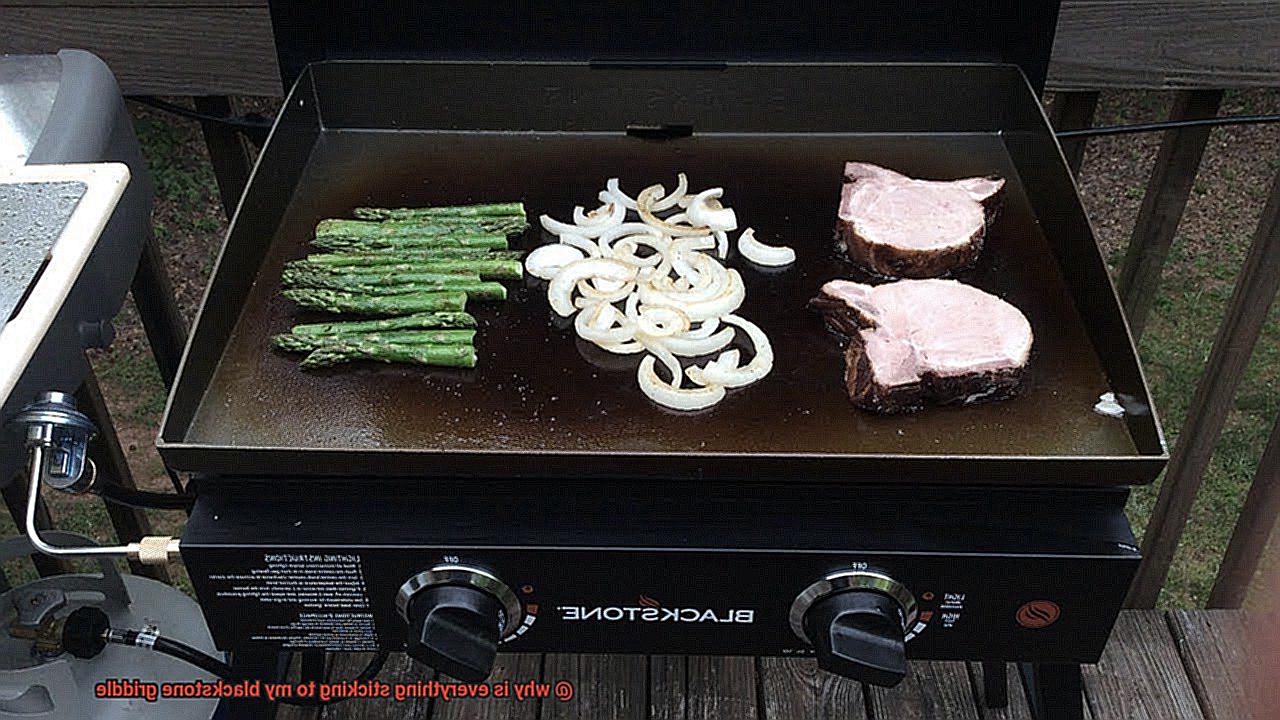
It’s also worth noting that some oils have distinct flavors that may impact the taste of your food. If you prefer a neutral taste, opt for vegetable oil or an oil labeled as “neutral” or “flavorless.”
How to Properly Clean and Maintain Your Blackstone Griddle
Follow these five ways to properly clean and maintain your griddle for optimal performance.
Step 1: Clean After Each Use
To prevent food from sticking, it is essential to clean your griddle after each use. Begin by scraping off any excess food or debris with a scraper or spatula. Then, pour a small amount of water onto the hot surface to loosen any remaining food or grease. Use a non-abrasive scrubber or pad to gently scrub the surface, being careful not to scratch or damage it. Rinse thoroughly with hot water and dry with a clean towel or cloth. This will remove any food particles and grease, preventing rust and other damage to the surface.
Step 2: Season Regularly
Seasoning involves coating the surface with oil and heating it up to create a non-stick surface. To season your griddle, clean it thoroughly as described above. Once the surface is dry, apply a thin layer of oil, such as vegetable or canola oil, over the entire surface of the griddle. Heat the griddle on medium-high heat until the oil begins to smoke. Turn off the heat and allow the griddle to cool completely. Repeat this process several times until a dark, non-stick surface has formed. Seasoning your griddle regularly will help prevent food from sticking.
Step 3: Preheat Before Cooking
To ensure that the surface is evenly heated and ready for cooking, preheat your griddle before cooking. Avoid overcrowding the surface of the griddle as this can cause food to steam instead of sear, which can lead to sticking.
Step 4: Use High-Heat Oil
Using a high-heat oil, such as vegetable or canola oil, to coat the surface of the griddle before cooking will help prevent food from sticking. Avoid using butter or olive oil, which have low smoke points and can burn easily.
Step 5: Maintain the Right Cooking Temperature
If the griddle is not hot enough, food will release moisture as it cooks, which can cause it to stick to the surface. Preheat your griddle for at least 10 minutes before cooking, and make sure that it reaches the desired temperature before adding your food. Maintaining the right cooking temperature will help prevent food from sticking and ensure perfectly cooked meals every time.
Common Mistakes to Avoid when Cooking on a Blackstone Griddle
Many home chefs make common mistakes when cooking on a Blackstone griddle that can result in food sticking to the surface. But with some expert advice, you can avoid these pitfalls and achieve perfectly cooked meals every time.
First things first, seasoning your Blackstone griddle is crucial. By applying oil to the surface and heating it up, you create a non-stick layer that prevents food from sticking. Skipping this step or not doing it properly can lead to major sticking issues. So take the time to season your griddle before use.
In addition to proper seasoning, using the right amount and type of oil is essential for preventing sticking. Using too much oil or the wrong type of oil can create a barrier between your food and the griddle, causing it to stick. So be mindful of the amount and type of oil you’re using.
Temperature control is another critical factor in preventing sticking. If the temperature is too low, food will stick to the surface instead of searing and releasing easily. Conversely, if the temperature is too high, there’s a risk of burning your food and making it stick even more. It’s important to find the right temperature for each type of food you’re cooking and adjust accordingly.
Lastly, cleaning your Blackstone griddle after each use – and deep cleaning regularly – is essential for preventing sticking. Built-up grease and food particles can create a sticky residue on the surface that will cause food to stick. So make sure to clean your griddle thoroughly after each use with hot soapy water and a grill brush.
Tips for Perfectly Cooked Meals Every Time
Here are some tips and tricks that you can use to ensure that your food slides right off the griddle.
Properly Season Your Griddle
Before cooking on your Blackstone griddle, it’s important to properly season it. This process involves coating the surface with a layer of oil and heating it up to create a non-stick layer. By seasoning your griddle, you not only prevent food from sticking but also protect the griddle from rust and other damage. To season your griddle, start by cleaning it thoroughly with soap and water. Once it is dry, apply a thin layer of oil to the surface and heat it up until it starts to smoke. Turn off the heat and let it cool down before wiping away any excess oil.
Preheat Your Griddle
One of the most crucial steps in achieving perfectly cooked meals on your Blackstone griddle is preheating it to the correct temperature before adding any food. A hot griddle helps create a sear on your food, which prevents sticking and ensures even cooking. It’s recommended to preheat your griddle for at least 10-15 minutes before cooking.
Use High Smoke Point Oils
Choosing the right cooking oil can make a significant difference in preventing food from sticking to your Blackstone griddle. Oils with high smoke points, such as vegetable or canola oil, work best as they do not burn or leave sticky residues on the surface of the griddle. On the other hand, butter or low smoke point oils tend to burn quickly and leave unpleasant residues on the surface.
Use the Right Tools
Using the appropriate tools when cooking on a Blackstone griddle can prevent scratching and damage to the surface. Heat-resistant silicone or wooden utensils are ideal choices instead of metal spatulas and tongs. These utensils do not scratch the surface, and they also help you handle and flip your food easily.
Don’t Overcrowd Your Griddle
Overcrowding your Blackstone griddle can lead to uneven cooking and food sticking to the surface. Therefore, it’s best to cook in batches, leaving enough space between each item to ensure even cooking and prevent steam from forming. This allows your food to cook evenly without touching and release moisture that might cause sticking.
kTQV7-xbWdE” >
Conclusion
In conclusion, don’t let stubborn food particles ruin your Blackstone griddle cooking experience. With a few practical solutions, you can conquer the issue of sticking food once and for all. Preheating your griddle to the right temperature and using high smoke point oils are crucial steps in preventing sticking. Properly seasoning and maintaining the surface is also key to achieving that non-stick perfection.
To ensure even cooking and prevent steam buildup, use the right tools and avoid overcrowding your griddle. And when it comes to cleaning, don’t skimp on it. Regular cleaning and deep cleaning are essential for preventing sticky residue from building up on the surface.
Remember, seasoning is an ongoing process that requires regular maintenance to maintain its non-stick properties. By following these tips and tricks, you can cook like a pro on your Blackstone griddle without any frustration or disappointment.

